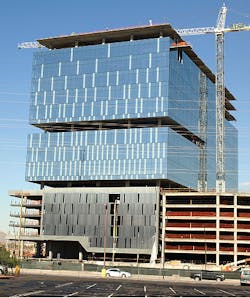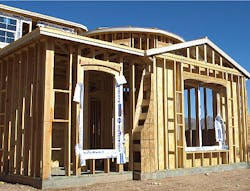Sponsored
You hear a lot these days about how smaller rep firms can survive against larger competitors with massive line cards and vast geographic territories by putting together a tight package of product lines and services to support a clearly defined market niche. Like most things in the rep world, it’s easier said than done, because line cards and relationships with distributors, electrical contractors, end users and electrical manufacturers are built brick-by-brick over the years. A late delivery, an inaccurate price quote, or an unfilled promise can undo years of a carefully cultivated business relationship.
At EDGReps (EDG), Mesa, Ariz., Nicole Bagozzi, company president, and her team use this approach to compete against larger reps and build their business throughout the Phoenix metropolitan area, the rest of Arizona and southern Nevada. The business, founded by Bud Ruzycki in 1984, is expanding fast in the LED and lighting solutions market, but also represents American Dryer, Fiber Tek, FRE Composites, JM Eagle, Martin Enterprises, Nehring, Remke, Solar Safe-D and Ventamatic. The relationships EDG developed over the years with distributors, electrical contractors and end users while representing these products in the Phoenix metropolitan area and adjacent sales territories often lead to business with their lighting lines, and vice versa. In the lighting market the company reps American Lighting, Energetic Lighting, Fulham, MaxLite, Resilient and Start Lighting.
Even though EDG spends much of its time guiding customers through the constantly evolving, cutting-edge technologies of the lighting market, they have found the evergreen business basics their beloved mentor Bud Ruzcycki taught them not only still apply, but differentiate them from other reps in the market. Nicole, who started with the company on the same day in 1997 as her husband, Ben, says Bud was all about making customers and employees feel special. Nicole and Ben started more than a new career when they first met that day — they got married several years later.
EDG still utilizes many of the management and service strategies Bud taught them, including providing employees with career advancement opportunities in the business, conducting customer training sessions and even delivering home-baked cookies to customers during the holiday season. Nicole says sometimes simply respecting the time vendors and customers give them on sale calls goes a long way toward building and maintaining their all-important relationships with them.
For instance, two weeks before a vendor comes in for joint sales calls, EDG lines up the appointments in the territory and then sends that itinerary to the vendor. Sounds simple, she says, but many of her vendors tell them relatively few reps are that prepared for their visits. “We don’t just swing into CED with them and ask to see the manager without an appointment,” she says. “Their time is just as valuable to them as it is to us.”
Curtis Moldenhauer, outside sales account manager, is a long-time veteran of the Phoenix electrical market who worked as an electrical contractor and in distribution before Bud convinced him to join EDG in 2003. He also met his wife, Catherine in the electrical market, while making sales calls. She eventually joined him at EDG to manage customer support for the firm.
Curtis says the most enduring lesson Bud taught him is the importance of developing relationships with customers and handling any problems face-to-face. “Bud taught me you start in the warehouse with distributors and see the shipping people and the counter guys before you even go inside,” he says. “When those guys get promoted, they will remember you. A lot of the guys that are now purchasing managers or managers were in inside sales and worked in the warehouse. We have grown up with them.”
Nicole, Ben and Curtis appreciated the career opportunities Bud gave them at EDG. Ben said Bud paid all of his health benefits while he was working part-time for EDG during college, and Nicole appreciated that Bud paid for her CPMR (Certified Professional Manufacturers Rep) training. “The beauty of EDG was that it gave everyone the opportunity to grow,” she says. “You are the only limitation. Bud’s motto was ‘We Are One,’ and that is how we operate. Our history has everything to do with Bud’s integrity. We hold that very dear.”
Bud always told them that he wanted EDG to be a place he would want to work even if he didn’t own the business, and Ben says this philosophy and his insistence on building customer relationships with all employees at a company, from the newest warehouse worker or truck driver to the company owner, was one of the key reasons he, Nicole and Curtis were able to keep the business alive after the previous owners shut it down shortly after buying it from Bud in 2009. Bud sold EDG to an investment group from the wastewater and engineering industry that Nicole and Ben say was mainly interested in buying EDG and other companies for tax reasons. A short time after buying EDG Enterprises, they gave Nicole, Ben and Curtis 30-day notice that they were shutting down the business.
It was decision time for Nicole, who was eight months pregnant. She, Curtis and Ben had to either get other jobs or make something happen with the industry contacts they had made through EDG. They decided to relaunch the company as EDGReps on Oct. 1, 2010. Ben says the customers never really got to know the investment group, but they knew Nicole, Curtis and him very well.
“Nicole had been running inside, Curtis was doing outside, I was working on the inside,” says Ben. “We would juggle the warehouse. The customers never really knew the new people who came in. Nothing changed as far as our manufacturers and distributors knew. We just had a couple of new phone numbers.”
It was an exciting and frightening time, remembers Nicole. “The sad part of it was that Bud had passed away. The silver lining was that we had all been doing it for so long, and that no one knew the owners. And we didn’t have to buy the company because they were dissolving it. They said, ‘Hey, we are done. You have 30 days to find another job. We had 30 days to get it together — a new business name, business plan, computers, banking, new contracts, website. And I was pregnant.”
Curtis said EDG’s line card didn’t change much when they relaunched the company as EDGReps and that they actually sharpened it a bit by “weeding out some goofy lines that didn’t mesh.”
They all agree a key reason EDG survived the transition is the amount of follow-up they do on orders once the customer places them. Today, Catherine Moldenhauer’s intense focus on follow-up helps make everything click while they are out in the field finalizing orders with customers, doing audits, running out to jobsites, working trade shows or conducting training classes.
“When our customers place an order, Catherine does everything from receiving the order, making sure it is in computer, looking at back orders and checking lead times,” says Nicole. “It’s more than just a date in the computer. She does all that follow-up and tracking.”
“They shouldn’t have to call us to find out where there shipments are at,” adds Curtis. “When they get their PO number, they should know. Customers say they are not getting this level of follow-up from other reps.”
Nicole says another big piece of the service equation at EDG is the help Amiee Paprocki provides in marketing. She redesigned the line card and is updating the company’s logo and website at www.edgreps.com to make them more user-friendly. “The little things are actually really big things,” says Nicole. “Aimie recreating our line card and doing things on the marketing side. Catherine doing things in customer service. Now customers aren’t calling for follow-up because they know Catherine takes care of it. Many of the calls coming in are new customers or inquiries. We have been able to create a good flow. I can take an order and set it up, but Catherine is there giving all of the support. Her position is just as valuable as everyone else’s.”
Amiee, who worked as a paralegal and in the financial services industry before recently joining EDG, says one thing she has learned about the electrical business is that customers and manufacturers all have their own preferred means of communication. Some people still like the telephone best, while others rely on Facebook Messenger, or the paper trail an e-mail provides.
Curtis says nothing beats face-to-face communications when a problem pops up out in the field. “When something happens, you put your boots on and get in the trenches,” he says. “People really respect that. If there is a problem on the jobsite, instead of e-mailing and texting back and forth I just say, ‘I will see you in 10 minutes.’
“They don’t expect that. All of a sudden it changes the dynamic — you are working together to resolve something. So many times they are so mad until they see you face-to-face. When you see someone face-to-face, it always changes.”
“There’s a place and a time for electronic devices,” adds Nicole. “They will never take the place of being face-to-face because this is a people business. It’s a balancing act trying to balance the customers and their needs with the agendas of the manufacturers. We are trying to keep them happy and increase market share, while at the same time maintain pricing for a distributor.”
The MOVE INTO LEDS
EDG blends its customer service approach with training, energy audits and building walk-throughs, and a carefully constructed package of lighting lines to support its rapidly growing business in LEDs. The company first started making a big push into the lighting market about 11 years ago with a package of induction lighting products. They liked selling induction lighting because of the dramatic energy savings it offered customers. In one of their bigger jobs with this technology, Curtis worked with the city of Sahuarita, Ariz., to save it 80% of the energy costs for its parks, city buildings and wastewater treatment plant.
Nicole and Curtis say LEDs came on faster than expected, fueled in part by rebate programs. They miss selling induction lighting because the proven energy savings they produced were easy to sell, but say LEDs now have a good track record and are widely accepted.
EDG’s approach to selling LEDs in some ways mirrors what they have done in other product areas they now rep or have repped in the past. The company only works with electrical manufacturers totally committed to selling through distributors, providing technical training, and out-servicing the competition.
“Customers are asking for different services like free audits and photometrics, job walks and rebates,” says Nicole. “We bring business and jobs to distributors. That’s a different model. I am not just going to distributors and saying, ‘What do you have for me to work on?’ I will say, ‘Hey, I have this project. Do you want to work on it with me?’ We are trying to think outside the box by going to specific market segments.”
Picking the right manufacturers has proved to be particularly important because new LED manufacturers often don’t understand the electrical channel, the role of electrical distributors in selling LED lighting, or EDG’s policy of repping only those LED manufacturers who only sell through electrical distribution.
Nicole says it seems like she gets five calls a week from new LED manufacturers who want EDG to take on their LED lamp line, but the company is very careful about selecting a partner.
“It seems like our size of line card is interesting to manufacturers because they don’t want to get lost in a line card with 80 to 90 lines,” she says. “They know that if they come with EDG they are going to get the face time, because we are planting the seeds. There are a lot of questions we ask in terms of support. I am not going to just hire any manufacturer. If we can’t get an answer from a manufacturer in a timely manner, then it looks like it’s EDG’s fault. I am only as good as my worst manufacturer.”
EDG’s team is particularly proud of their growth with the MaxLite product line, which it took on in 2011 and has grown sales from $100,000 the first year to over $1 million in 2015. Nicole says EDG is cautiously building its LED package to maintain the right mix of vendors and is still looking for a lighting control line.
Curtis says an interesting nuance with EDG’s LED lines is that they sometimes work together with the company’s solar manufacturer, Solar Safe-D, a manufacturer of solar combiner boxes and control panels. It makes sense for solar customers to first retrofit their lighting system with LEDs so they can size their solar electric system appropriately. “Instead of just putting the solar panels on the house, it’s, ‘Let’s fix the lighting first because the ROI will come even faster.’ They kind of mix and mosh,” he says.
On the training front, Nicole and her team often teach LED basics to customers. One particularly successful presentation on LED retrofits was for a Catholic church in Phoenix. It was so convincing that the word spread other Catholic churches in the area and EDG now regularly retrofits facilities for the Phoenix Catholic Archdiocese. Says Nicole, “We started doing free audits for all of the churches. We went in there to do a lighting presentation for the whole Phoenix Diocese — 50-70 churches — and we were the only lighting people there. We were able to present to all of these churches and offer all of these retrofit services for free, and we get to go back in and have some pull-through business.”
Curtis believes the LED technology is flattening and that the next big thing in lighting will be wireless control via WiFi. EDG has done some major retrofits for the Mayo Clinic located in Phoenix, and their contacts there eventually want to control their outdoor lighting wirelessly with a phone app.
While LEDs are maturing and price will continue to be an important consideration, Nicole says EDG must continue to select the right partners and keep up with the technology. “Design and functionality continue to change in the market,” she says. “We are also seeing a lot of improvement in the retrofit technology and it’s crucial to be knowledgeable about all of the different options for LED retrofit solutions that are application based.
“Our customers appreciate our ability to offer more than one kind of solution. Each of our vendors bring something different to the table. What makes us more effective is the ability to work with our manufacturers to offer the best solution at the best pricing with the best service.”
“It’s been a fun ride,” says Nicole. “I would not want to be entering the market now. There are a lot of barriers to entry. We were all trained by people who had many years in the industry, and we have tried to stick with the core beliefs of how this business should be run.”
SIDEBAR
Lighting Tempe’s Mill St. Bridge
The EDG team has worked on some interesting lighting retrofits over the years, but they agree the relighting of Mill St. Bridge in downtown Tempe, Ariz., probably best exemplifies a smooth manufacturer-rep-distributor relationship while working together on a high-profile project that provides exceptional energy savings.
Working with EDG, MaxLite and Summit Electric Supply, the city replaced 4,500 3W cold cathode fluorescent bulbs with MaxLite’s 2.5W LED marquee lamps. By switching to LEDs, the city will save 112,500 kWh and $183,375 in energy and maintenance costs over the 50,000-hour lifetime of the lamps, according to a Maxlite press release.
Just 24 hours after the call first came from the city of Tempe about the project, MaxLite delivered product samples. And MaxLite’s CEO shifted production at the company’s factory in Korea to produce the necessary lamps and then air-freighted them at its own expense.
Says Ben Bagozzi, “It was a perfect storm and everything had to happen right. Changing production. Getting the right product to the customer when they needed it. It was really cool the way it happened.”






